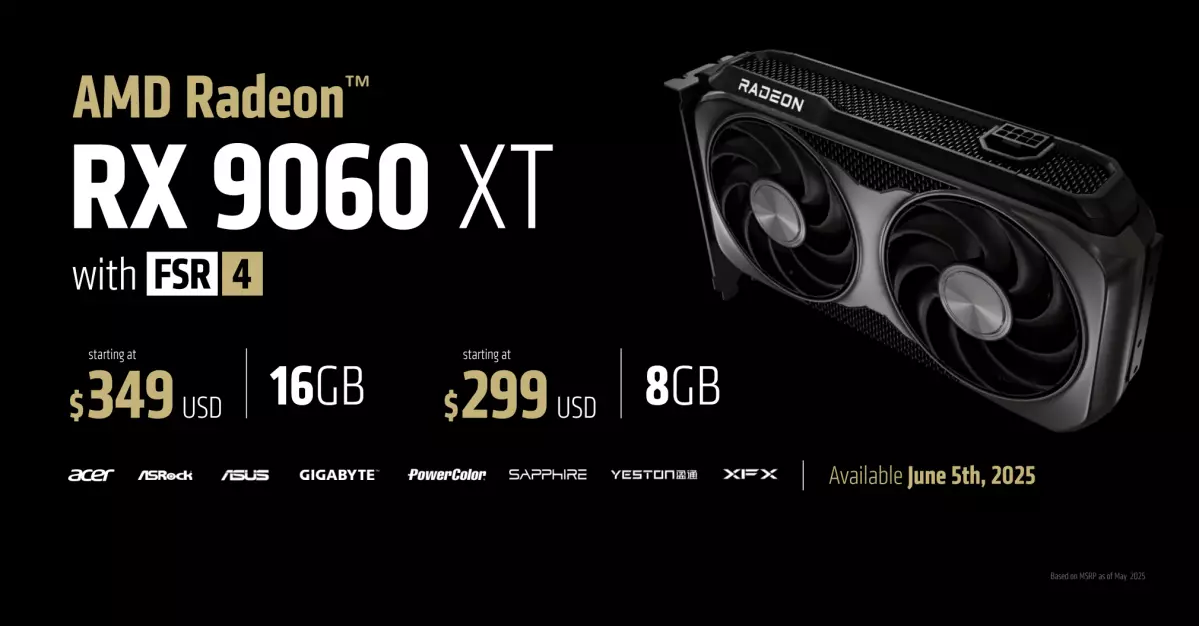In a bold stride for the graphics card market, AMD has unveiled its latest offering, the Radeon RX 9060 XT GPU, at Computex. This new graphics card is designed to directly challenge Nvidia’s recently released RTX 5060 and RTX 5060 Ti models, and while the specifics surrounding pricing and availability remain sparse, the implications of AMD’s strategic decisions are becoming increasingly evident. The conversation surrounding GPU specifications, specifically regarding VRAM, has ignited fervent debates among gamers and tech enthusiasts alike.
The Competitive Landscape: AMD vs. Nvidia
The RX 9060 XT comes with options for either 8GB or 16GB of VRAM, priced at $299 and $349, respectively. This dual offering puts AMD in a position to cater to different segments of the market, but it also raises questions about their timing and the relevance of their VRAM choices. Nvidia’s decision to launch its 50-series GPUs with just 8GB of VRAM has been contentious, particularly in an era where games increasingly demand more memory bandwidth to run smoothly. AMD’s dual offerings may provide performance boosts, but the benchmark comparisons will ultimately dictate their market success.
The peculiarity lies in the implicit endorsement of such a limited VRAM allocation by both companies. Gamers have expressed significant concerns about the potential bottlenecks that can arise from the 8GB VRAM specification, questioning if AMD is merely following Nvidia’s controversial lead. This hesitant approach to VRAM could turn out to be a gamble that backfires if the gaming community demands more robust solutions as titles evolve. The looming question remains—are both companies misreading the demands of the gaming market, or is there strategic reasoning behind their choices?
Technical Specifications: A Glimpse into Performance
Diving deeper into the RX 9060 XT, the card boasts 32 RDNA 4 compute units and a boost clock reaching 3.13GHz. While those numbers seem promising, the real test will be in its real-world performance, particularly at 1440p resolution where AMD claims a roughly 6% performance advantage over Nvidia’s RTX 5060 Ti. However, this assertion bears scrutiny; AMD’s benchmarks are self-reported, and without independent assessments, skepticism will thrive.
Moreover, both variants support cutting-edge DisplayPort 2.1a and HDMI 2.1b technologies, which is a noteworthy feature catering to the latest high-refresh-rate monitors and emerging displays. Yet, the total board power varying between 150 to 182 watts raises further questions about efficiency and heat management. Efficiency is critical in an industry pushing for sustainable computing solutions while providing top-tier performance.
The Controversy Surrounding VRAM: What Gamers Should Know
As the debate rages on over the adequacy of 8GB of VRAM, AMD finds itself drawing fire from the gaming community. Reviewers have consistently pointed out the increasing memory demands of modern games. With titles showcasing high fidelity graphics, the future of gaming could very well depend on how these GPUs handle memory-intensive processes. The fallout from Nvidia’s early release amidst allegations of withholding driver access from reviewers further complicates AMD’s positioning.
The implications extend beyond mere specifications; gamers rely on transparency and integrity in the industry. Allegations that Nvidia pressured media outlets to bend to its narrative in benchmarking processes are concerning. How this perceived manipulation will affect public trust in both Nvidia and AMD remains to be seen. If AMD is also seen adopting similar practices, it could potentially shift consumer sentiment against them.
Looking Ahead: AMD’s Prospects in a Rapidly Evolving Market
As AMD launches the RX 9060 XT, how it navigates the complex landscape will determine not just the success of this release, but possibly its long-term position in the competitive GPU market. The reliance on VRAM and benchmark integrity will be key as both consumer expectations and technological requirements continue to escalate.
AMD’s RX 9060 XT represents more than just a new graphics card; it’s a reflection of market dynamics and a barometer for consumer sentiment on performance versus pricing. As gamers await independent reviews and practical benchmarks, the industry watches closely, waiting to see if AMD can solidify its place amidst shifting tides in the gaming world.

